IVSS How Projects Are Judged
IVSS: How Projects Are Judged (Rubrics)
Volunteer judges from around the world rate each submitted International Virtual Science Symposium report using an age-appropriate rubric to provide feedback to students. These rubrics are updated most years.
Rubrics for the 2022-2025 symposia are listed below by grade level/age. Students and teachers are encouraged to use this information to support the report writing and research process.Search and review IVSS submitted projects from 2024.
2023 - 2025
| Four Stars (Exceptional) | Three Stars (Good) | Two Stars (Needs Improvement) | One Star (Insufficient) |
|---|---|---|---|
|
|
|
|
Project elements and criteria for High School and Undergraduate, ages 14-18+
* required element
1. Title*
- Concise (less than 15 words)
- Summarizes paper’s content
2. Abstract*
- Concise (less than 300 words)
- Context of research
- Research questions
- Objectives set
- Brief methods description
- Results
- Conclusions
- Recommendations for a way forward
- Key words that emphasize key ideas in the paper (3-5 words)
3. Research Questions*
- Include why they are important and are of scientific interest
- Concern some aspect of Earth’s environment (local or global issue)
- Provide significant insight into both the topic of investigation and the research process
- Answering them requires an advanced understanding of the subject matter
- Require a thoughtful research plan
- Are answerable through scientific research appropriate to the scope of the report
4. Introduction & Review of Literature
- Thorough (250-500 words)
- Description of the problem
- State of the science
- Importance
- Community relevance
- Citations in text (at least 3-5 references, including one primary source in a peer-reviewed journal. Do not include wikis or Q&A sites such as answers.com.
- Tip: Check out the The Purdue "OWL" for guidance and resources
5. Research Methods*
- There is a direct link provided between the datasets and research question(s)
- Study site: A map and description of the study site. It should mention area of study, climatic characteristics and basic aspects of land cover
- Data collection: A description of GLOBE protocols used to answer the research question as well as where and how data was gathered in the field (sampling method: Where, how many samples were measured)
- Print screen of data entry in the Web page of GLOBE.
- Data analysis: Mention what kind of mathematical calculation was applied to analyze the data
- The data presented are sufficient to answer the research question(s)
6. Results
- Tables and graphics applying statistical analysis of data to show mean, dispersion, or grouping data.
- Data support the conclusions
- Print screen of GLOBE Visualization page
7. Discussion
- Interpretation of results
- Possible sources of error
- Comparison with similar studies
- Discuss whether results support the hypothesis or not, and why
8. Conclusion*
- Gives a thorough and insightful explanation as to how the conclusion was reached
- Put findings in context, why it's important/relevant, impact, with regard to the science
- What improvements in methods
- What follow-on research/actions to be taken, future protocols that could be added
- Impact of working with a project mentor
9. Bibliography/Citations
- Materials correctly cited
- GLOBE materials used
- Sources beyond those powered by GLOBE
| Four Stars (Exceptional) | Three Stars (Good) | Two Stars (Needs Improvement) | One Star (Insufficient) |
|---|---|---|---|
|
|
|
|
Project elements and criteria for Middle School, ages 11-14 yrs
* required element
1. Title*
- Concise (less than 15 words)
- Summarizes paper’s content
2. Abstract*
- Concise (less than 300 words)
- Context of research
- Research questions
- Objectives set
- Brief methods description
- Results
- Conclusions
- Recommendations for a way forward
- Key words that emphasize key ideas in the paper (3-5 words)
3. Research Questions*
- Include why they are important and are of scientific interest
- Concern some aspect of Earth’s environment (local or global issue)
- Provide significant insight into both the topic of investigation and the research process
- Answering them requires an advanced understanding of the subject matter
- Require a thoughtful research plan
- Are answerable through scientific research appropriate to the scope of the report
4. Introduction & Review of Literature
- Thorough (250-500 words)
- Description of the problem
- State of the science
- Importance
- Community relevance
- Citations in text (at least 3-5 references, including one primary source in a peer-reviewed journal. Do not include wikis or Q&A sites such as answers.com.
- Tip: Check out the The Purdue "OWL" for guidance and resources
5. Research Methods*
- There is a direct link provided between the datasets and research question(s)
- Study site: A map and description of the study site. It should mention area of study, climatic characteristics and basic aspects of land cover
- Data collection: A description of GLOBE protocols used to answer the research question as well as where and how data was gathered in the field (sampling method: Where, how many samples were measured)
- Print screen of data entry in the Web page of GLOBE.
- Data analysis: Mention what kind of mathematical calculation was applied to analyze the data
- The data presented are sufficient to answer the research question(s)
6. Results
- Tables and graphics applying statistical analysis of data to show mean, dispersion, or grouping data.
- Data support the conclusions
- Print screen of GLOBE Visualization page
7. Discussion
- Interpretation of results
- Possible sources of error
- Comparison with similar studies
- Discuss whether results support the hypothesis or not, and why
8. Conclusion*
- Gives a thorough and insightful explanation as to how the conclusion was reached
- Put findings in context, why it's important/relevant, impact, with regard to the science
- What improvements in methods
- What follow-on research/actions to be taken, future protocols that could be added
- Impact of working with a project mentor
9. Bibliography/Citations
- Materials correctly cited
- GLOBE materials used
- Sources beyond those powered by GLOBE
| Four Stars (Exceptional) | Three Stars (Good) | Two Stars (Needs Improvement) | One Star (Insufficient) |
|---|---|---|---|
|
|
|
|
Project elements and criteria for Grades 3-5 Upper Primary, ages 8-11
* required element
1. Title*
- Concise (less than 15 words)
- Summarizes paper’s content
2. Summary*
- The problem
- Research questions
- Objectives set
- Conclusions
3. Research Questions*
- Include why they are important and are of scientific interest
- Concern some aspect of Earth’s environment (local or global issue)
- Provide significant insight into both the topic of investigation and the research process
- Require a thoughtful research plan
- Are answerable through scientific research appropriate to the scope of the report
4. Introduction
- Description of the problem
- Importance
- Community relevance
5. Research Methods*
- There is a direct link provided between the datasets and research question(s)
- Study site: A map and description of the study site. It should mention area of study, climatic characteristics and basic aspects of land cover
- Data collection: A description of GLOBE protocols used to answer the research question as well as where and how data was gathered in the field (sampling method: Where, how many samples were measured)
- Print screen of data entry in the Web page of GLOBE.
- The data presented are sufficient to answer the research question(s)
6. Results
- Tables and graphics of data
- Data support the conclusions
8. Conclusion*
- Gives a thorough and insightful explanation as to how the conclusion was reached
- Put findings in context, stating why they are important or relevant
- What follow-on research and actions could be taken; future protocols that could be added
- Impact of working with a project mentor
9. Bibliography
- Materials listed
- GLOBE materials used
| Four Stars (Exceptional) | Three Stars (Good) | Two Stars (Needs Improvement) | One Star (Insufficient) |
|---|---|---|---|
|
|
|
|
Project elements and criteria for Grades K-2, ages 5-8
* required element
1. Title*
- Concise (less than 15 words)
- Summarizes paper’s content
2. Summary*
- The problem
- Research questions
- Conclusions
3. Research Questions*
- Include why they are important and are of scientific interest
- Concern some aspect of Earth’s environment (local or global issue)
- Are answerable through scientific research appropriate to the scope of the report
5. Research Methods*
- There is a direct link provided between the datasets and research question(s)
- Data collection: A description of GLOBE protocols used to answer the research question as well as where and how data was gathered in the field (sampling method: Where, how many samples were measured)
- The data presented are sufficient to answer the research question(s)
6. Results
- Tables and graphics of data
- Data support the conclusions
8. Conclusion*
- Gives a thoughtful explanation as to how the conclusion was reached
- Put findings in context, stating why they are important or relevant
- Impact of working with a project mentor or teacher(s)
2022

Project elements and criteria for High School and Undergraduate, ages 14-18+
* required element
1. Title*
- Concise (less than 15 words)
- Summarizes paper’s content
2. Abstract*
- Concise (less than 300 words)
- Context of research
- Research questions
- Objectives set
- Brief methods description
- Results
- Conclusions
- Recommendations for a way forward
- Key words that emphasize key ideas in the paper (3-5 words)
3. Research Questions*
- Include why they are important and are of scientific interest
- Concern some aspect of Earth’s environment (local or global issue)
- Provide significant insight into both the topic of investigation and the research process
- Answering them requires an advanced understanding of the subject matter
- Require a thoughtful research plan
- Are answerable through scientific research appropriate to the scope of the report
4. Introduction & Review of Literature
- Thorough (250-500 words)
- Description of the problem
- State of the science
- Importance
- Community relevance
- Citations in text (at least 3-5 references, including one primary source in a peer-reviewed journal. Do not include wikis or Q&A sites such as answers.com.
- Tip: Check out the The Purdue "OWL" for guidance and resources
5. Research Methods*
- There is a direct link provided between the datasets and research question(s)
- Study site: A map and description of the study site. It should mention area of study, climatic characteristics and basic aspects of land cover
- Data collection: A description of GLOBE protocols used to answer the research question as well as where and how data was gathered in the field (sampling method: Where, how many samples were measured)
- Print screen of data entry in the Web page of GLOBE.
- Data analysis: Mention what kind of mathematical calculation was applied to analyze the data
- The data presented are sufficient to answer the research question(s)
6. Results
- Tables and graphics applying statistical analysis of data to show mean, dispersion, or grouping data.
- Data support the conclusions
- Print screen of GLOBE Visualization page
7. Discussion
- Interpretation of results
- Possible sources of error
- Comparison with similar studies
- Discuss whether results support the hypothesis or not, and why
8. Conclusion*
- Gives a thorough and insightful explanation as to how the conclusion was reached
- Put findings in context, why it's important/relevant, impact, with regard to the science
- What improvements in methods
- What follow-on research/actions to be taken, future protocols that could be added
- Impact of working with a project mentor
9. Bibliography/Citations
- Materials correctly cited
- GLOBE materials used
- Sources beyond those powered by GLOBE

Project elements and criteria for Middle School, ages 11-14 yrs
* required element
1. Title*
- Concise (less than 15 words)
- Summarizes paper’s content
2. Abstract*
- Concise (less than 300 words)
- Context of research
- Research questions
- Objectives set
- Brief methods description
- Results
- Conclusions
- Recommendations for a way forward
- Key words that emphasize key ideas in the paper (3-5 words)
3. Research Questions*
- Include why they are important and are of scientific interest
- Concern some aspect of Earth’s environment (local or global issue)
- Provide significant insight into both the topic of investigation and the research process
- Answering them requires an advanced understanding of the subject matter
- Require a thoughtful research plan
- Are answerable through scientific research appropriate to the scope of the report
4. Introduction & Review of Literature
- Thorough (250-500 words)
- Description of the problem
- State of the science
- Importance
- Community relevance
- Citations in text (at least 3-5 references, including one primary source in a peer-reviewed journal. Do not include wikis or Q&A sites such as answers.com.
- Tip: Check out the The Purdue "OWL" for guidance and resources
5. Research Methods*
- There is a direct link provided between the datasets and research question(s)
- Study site: A map and description of the study site. It should mention area of study, climatic characteristics and basic aspects of land cover
- Data collection: A description of GLOBE protocols used to answer the research question as well as where and how data was gathered in the field (sampling method: Where, how many samples were measured)
- Print screen of data entry in the Web page of GLOBE.
- Data analysis: Mention what kind of mathematical calculation was applied to analyze the data
- The data presented are sufficient to answer the research question(s)
6. Results
- Tables and graphics applying statistical analysis of data to show mean, dispersion, or grouping data.
- Data support the conclusions
- Print screen of GLOBE Visualization page
7. Discussion
- Interpretation of results
- Possible sources of error
- Comparison with similar studies
- Discuss whether results support the hypothesis or not, and why
8. Conclusion*
- Gives a thorough and insightful explanation as to how the conclusion was reached
- Put findings in context, why it's important/relevant, impact, with regard to the science
- What improvements in methods
- What follow-on research/actions to be taken, future protocols that could be added
- Impact of working with a project mentor
9. Bibliography/Citations
- Materials correctly cited
- GLOBE materials used
- Sources beyond those powered by GLOBE

Project elements and criteria for Grades 3-5 Upper Primary, ages 8-11
* required element
1. Title*
- Concise (less than 15 words)
- Summarizes paper’s content
2. Summary*
- The problem
- Research questions
- Objectives set
- Conclusions
3. Research Questions*
- Include why they are important and are of scientific interest
- Concern some aspect of Earth’s environment (local or global issue)
- Provide significant insight into both the topic of investigation and the research process
- Require a thoughtful research plan
- Are answerable through scientific research appropriate to the scope of the report
4. Introduction
- Description of the problem
- Importance
- Community relevance
5. Research Methods*
- There is a direct link provided between the datasets and research question(s)
- Study site: A map and description of the study site. It should mention area of study, climatic characteristics and basic aspects of land cover
- Data collection: A description of GLOBE protocols used to answer the research question as well as where and how data was gathered in the field (sampling method: Where, how many samples were measured)
- Print screen of data entry in the Web page of GLOBE.
- The data presented are sufficient to answer the research question(s)
6. Results
- Tables and graphics of data
- Data support the conclusions
8. Conclusion*
- Gives a thorough and insightful explanation as to how the conclusion was reached
- Put findings in context, stating why they are important or relevant
- What follow-on research and actions could be taken; future protocols that could be added
- Impact of working with a project mentor
9. Bibliography
- Materials listed
- GLOBE materials used

Project elements and criteria for Grades K-2, ages 5-8
* required element
1. Title*
- Concise (less than 15 words)
- Summarizes paper’s content
2. Summary*
- The problem
- Research questions
- Conclusions
3. Research Questions*
- Include why they are important and are of scientific interest
- Concern some aspect of Earth’s environment (local or global issue)
- Are answerable through scientific research appropriate to the scope of the report
5. Research Methods*
- There is a direct link provided between the datasets and research question(s)
- Data collection: A description of GLOBE protocols used to answer the research question as well as where and how data was gathered in the field (sampling method: Where, how many samples were measured)
- The data presented are sufficient to answer the research question(s)
6. Results
- Tables and graphics of data
- Data support the conclusions
8. Conclusion*
- Gives a thoughtful explanation as to how the conclusion was reached
- Put findings in context, stating why they are important or relevant
- Impact of working with a project mentor or teacher(s)





